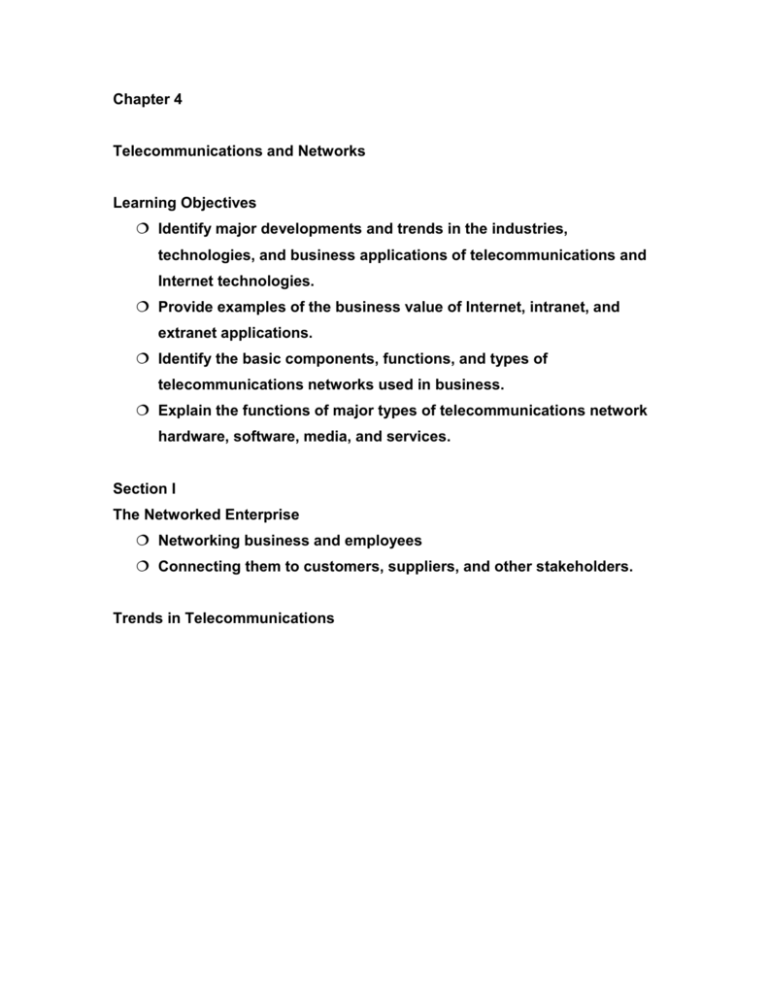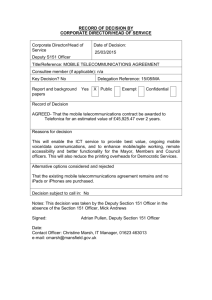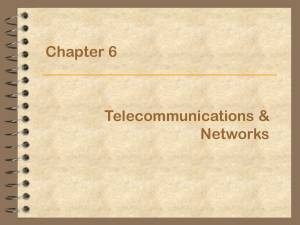Chapter 4
advertisement

Chapter 4 Telecommunications and Networks Learning Objectives Identify major developments and trends in the industries, technologies, and business applications of telecommunications and Internet technologies. Provide examples of the business value of Internet, intranet, and extranet applications. Identify the basic components, functions, and types of telecommunications networks used in business. Explain the functions of major types of telecommunications network hardware, software, media, and services. Section I The Networked Enterprise Networking business and employees Connecting them to customers, suppliers, and other stakeholders. Trends in Telecommunications Industry More competitive More options for the firm Technology Unrestricted connectivity Easy access for end users Open systems Use common standards for hardware, software, applications, & networking High degree of interoperability Digital networks Higher transmission speeds Moves larger amounts of information Greater economy Lower error rates Multiple types of communications on the same circuits Fiber-optic lines & cellular, PCS, satellite & other wireless technologies Faster transmission speeds Business applications Dramatic increase in the number of feasible telecommunication applications. Cut costs, reduce lead times, shorten response times, support e-commerce, improve collaboration, share resources, lock in customers & suppliers, & develop new products & services Business Value of Telecommunications Networks The Internet A network of networks Popular uses E-mail Instant messaging Browsing the World Wide Web Newsgroups and chat rooms The business value of the Internet Intranets Within an organization Uses Internet technologies Business value of Intranets Used for information sharing, communication, collaboration, & support of business processes. Web publishing Comparatively easy, attractive, & lower cost alternative for publishing & accessing multimedia business information Business Operations & Management Used for developing & deploying critical business applications Supports operations and managerial decision making Extranets Network links that use Internet technologies to interconnect the firm’s intranet with the intranets of customers, suppliers, or other business partners Consultants, subcontractors, business prospects, & others Business value Improve communication with customers and business partners Gain competitive advantage in Product development Cost savings Marketing Distribution Leveraging their partnerships Section II Telecommunications Network Alternatives A Telecommunications Network Model Consists of five basic components Terminals Any input/output device that uses telecommunication networks to transmit or receive data Telecommunication processors Support data transmission and reception between terminals and computers Telecommunications channels The medium over which data are transmitted and received Computers Interconnected by telecommunications networks Telecommunications control software Control telecommunications activities & manage the functions of telecommunications networks Types of Telecommunications Networks Wide Area Networks (WAN) Cover a large geographic area. Local Area Networks (LAN) Connect computers & other information processing devices within a limited physical area. Connected via ordinary telephone wiring, coaxial cable, or wireless radio & infrared systems Virtual Private Networks A secure network that uses the Internet as its main backbone network, but relies on fire walls and other security features Client/Server Networks Clients – end user PCs or NCs Server – helps with application processing and also manages the network Network computing “the network is the computer” Thin clients process small application programs called “applets.” Peer-to-Peer (P2P) Two major models Central server architecture Pure peer-to-peer Telecommunications Media Twisted-pair wire Coaxial cable Minimizes interference and distortion Allows high-speed data transmission Fiber optics Glass fiber that conducts pulses of light generated by lasers Size and weight reduction Increased speed and carrying capacity Wireless Technologies Terrestrial Microwave Line-of-sight path between relay stations spaced approximately 30 miles apart. Communications Satellites Geosynchronous orbits Serve as relay stations for communications signals transmitted from earth stations Cellular & PCS Systems Each cell is typically from one to several square miles in area. Each cell has its own low-power transmitter or radio relay antenna. Computers & other communications processors coordinate & control the transmissions to/from mobile users as they move from one cell to another Wireless LANs Spread spectrum Wi-Fi (wireless fidelity) Wireless Web Uses Web-enabled information appliances Very thin clients Telecommunications Processors Modems (modulation/demodulation) Changes signals from analog to digital and back to analog Multiplexers Allows a single communication channel to carry simultaneous data transmissions from many terminals Internetwork Processors Switches Makes connections between telecomm circuits so a message can reach its intended destination Router Interconnects networks based on different rules or protocols Hub Port switching communications processor Gateway A processor that interconnects networks that use different communications architecture Telecommunications Software Provides a variety of communications support services including connecting & disconnecting communications links & establishing communications parameters such as transmission speed, mode, and direction. Network Management Traffic management Security Network monitoring Capacity planning Network Topologies Star Ties end user computers to a central computer Considered the least reliable Ring (sometimes called Token Ring) Ties local computer processors together in a ring on a more equal basis. Considered more reliable & less costly Bus Local processors share the same bus, or communications channel Tree is a variation which ties several bus networks together Network Architectures & Protocols Protocols A standard set of rules & procedures for the control of communications in a network Standards for the physical characteristics of cables and connectors Network Architecture Goal is to promote an open, simple, flexible, efficient telecommunications environment OSI Model TCP/IP Transmission Control Protocol/Internet Protocol Used by the Internet and all intranets and extranets Bandwidth Alternatives Bandwidth is the frequency range of a telecommunications network Determines the channel’s maximum transmission rate Measured in bits per second (bps) or baud Narrow-band Low-speed transmission Broadband High-speed transmission Switching Alternatives Circuit switching Packet switching Cell switching




